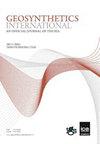Semi-analytical model for axisymmetric transport of contaminant through flawed geomembrane
IF 3.3
2区 工程技术
Q2 ENGINEERING, GEOLOGICAL
引用次数: 0
Abstract
Geomembrane (GM) is a kind of cost-efficient material for pollutant barrier in landfills, while defects can occur during the installation or service periods, resulting in a mixed-type boundary condition (MTBC) at the top surface of underlying soil layer (SL). In this study, a novel boundary transform method is employed to handle the MTBC problem of axisymmetric transport of organic contaminant through defected GM, and a semi-analytical solution is derived to evaluate the concentration profiles in the spatiotemporal domain. The proposed solution is in the cylindrical coordinates that can incorporate the diffusion and dispersion processes, as well as the concentration condition in the GM defect. The discretization method, integral transforms and corresponding inverse transforms are applied to obtain the semi-analytical solution, which is demonstrated effective compared to the numerical results. The model is applied to predict the migration characteristics of organic contaminant in several cases, followed by discussions to evaluate the influencing roles of defect rate, anisotropic coefficient, and segment number. Results indicate that the existence of defects substantially reduces the barrier capacity of the GM layer, and the contaminant migration time varies in several orders of magnitude for different MTBCs.污染物通过有缺陷土工膜轴对称运移的半解析模型
土工膜(GM)是一种经济高效的垃圾填埋场污染物屏障材料,但土工膜在安装或使用期间会出现缺陷,导致下垫层(SL)上表面出现混合型边界条件(MTBC)。本文采用一种新的边界变换方法来处理有机污染物通过缺陷GM轴对称迁移的MTBC问题,并推导出一个半解析解来评价其时空浓度分布。所提出的解是在柱面坐标系中,可以包含扩散和分散过程,以及GM缺陷中的浓度条件。采用离散化方法、积分变换和相应的逆变换,得到了半解析解,与数值结果对比表明,该方法是有效的。应用该模型预测了几种情况下有机污染物的迁移特性,并讨论了缺陷率、各向异性系数和段数对迁移特性的影响。结果表明,缺陷的存在大大降低了转基因层的屏障能力,并且不同mtbc的污染物迁移时间存在几个数量级的差异。
本文章由计算机程序翻译,如有差异,请以英文原文为准。
求助全文
约1分钟内获得全文
求助全文
来源期刊

Geosynthetics International
ENGINEERING, GEOLOGICAL-GEOSCIENCES, MULTIDISCIPLINARY
CiteScore
6.90
自引率
20.00%
发文量
91
审稿时长
>12 weeks
期刊介绍:
An online only, rapid publication journal, Geosynthetics International – an official journal of the International Geosynthetics Society (IGS) – publishes the best information on current geosynthetics technology in research, design innovation, new materials and construction practice.
Topics covered
The whole of geosynthetic materials (including natural fibre products) such as research, behaviour, performance analysis, testing, design, construction methods, case histories and field experience. Geosynthetics International is received by all members of the IGS as part of their membership, and is published in e-only format six times a year.
 求助内容:
求助内容: 应助结果提醒方式:
应助结果提醒方式:


